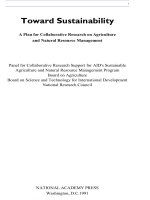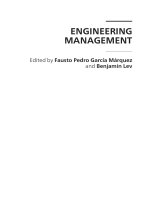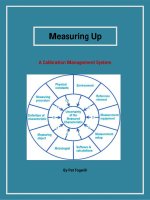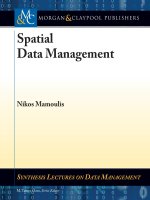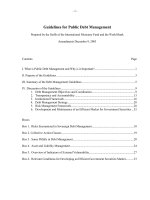ENGINEERING MANAGEMENT potx
Bạn đang xem bản rút gọn của tài liệu. Xem và tải ngay bản đầy đủ của tài liệu tại đây (6.87 MB, 240 trang )
ENGINEERING
MANAGEMENT
Edited by Fausto Pedro García Márquez
and Benjamin Lev
Engineering Management
/>Edited by Fausto Pedro García Márquez and Benjamin Lev
Contributors
Margaret Olubunmi Afolabi, Omoniyi Ola-Olorun, William Fox, Fausto Pedro García Márquez, Mahelet Fikru, Jose-
Ignacio Munoz-Hernandez, Jose-Ramon Otegi-Olaso, Alejandro Gutierrez-Lopez, Julen Rubio, Marta Ramos Martín
Nieto, Benjamin Lev, Wenjing Shen, Xinxin Hu, Yi Liao, Joaquín López Pascual
Published by InTech
Janeza Trdine 9, 51000 Rijeka, Croatia
Copyright © 2013 InTech
All chapters are Open Access distributed under the Creative Commons Attribution 3.0 license, which allows users to
download, copy and build upon published articles even for commercial purposes, as long as the author and publisher
are properly credited, which ensures maximum dissemination and a wider impact of our publications. After this work
has been published by InTech, authors have the right to republish it, in whole or part, in any publication of which they
are the author, and to make other personal use of the work. Any republication, referencing or personal use of the
work must explicitly identify the original source.
Notice
Statements and opinions expressed in the chapters are these of the individual contributors and not necessarily those
of the editors or publisher. No responsibility is accepted for the accuracy of information contained in the published
chapters. The publisher assumes no responsibility for any damage or injury to persons or property arising out of the
use of any materials, instructions, methods or ideas contained in the book.
Publishing Process Manager Iva Lipovic
Technical Editor InTech DTP team
Cover InTech Design team
First published March, 2013
Printed in Croatia
A free online edition of this book is available at www.intechopen.com
Additional hard copies can be obtained from
Engineering Management, Edited by Fausto Pedro García Márquez and Benjamin Lev
p. cm.
ISBN 978-953-51-1037-8
free online editions of InTech
Books and Journals can be found at
www.intechopen.com
Contents
Preface VII
Chapter 1 Heuristic Approaches for a Dual Optimization Problem 1
Fausto Pedro García Márquez and Marta Ramos Martín Nieto
Chapter 2 Comparisons of Lateral Transshipment with Emergency Order
Policies 23
Yi Liao, Wenjing Shen, Xinxin Hu and Benjamin Lev
Chapter 3 Modeling Engineering Management Decisions with
Game Theory 43
William P. Fox
Chapter 4 Managing Pharmacy Operations with People and
Technology 69
Margaret O. Afolabi and Omoniyi Joseph Ola-Olorun
Chapter 5 Improving Mandatory Environmental Data Reporting for
Comparable and Reliable Environmental Performance
Indicators 95
Mahelet G. Fikru
Chapter 6 Technology Assessment in Software Development Projects
Using a System Dynamics Approach: A Case of Application
Frameworks 119
José Ignacio Muñoz Hernández, José Ramón Otegui Olaso and
Alejandro Gutiérrez López
Chapter 7 Technical Performance Based Earned Value as a Management
Tool for Engineering Projects 143
José Ignacio Muñoz Hernández, José Ramón Otegui Olaso and
Julen Rubio Gómez
Chapter 8 The Investment in Hedge Funds as an Alternative
Investment 167
Joaquín López Pascual
Chapter 9 Modeling and Linear Programming in Engineering
Management 181
William P. Fox and Fausto P. Garcia
ContentsVI
Preface
The Engineering Management book synthesises the engineering principles with business
practice, i.e. the book provides an interface between the main disciplines of engineering/
technology and the organizational, administrative, and planning abilities of management. It
is complementary to other sub-disciplines such as economics, finance, marketing, decision
and risk analysis, etc.
This book is intended for engineers, economics and researchers who are developing new
advances in engineering management, or who employ the engineering management disci‐
pline as part of their work. The authors of this volume describe their pioneering work in the
area or provide material for case studies successfully applying the engineering management
discipline in real life cases.
The first chapter describes a real life case study with dual optimization. It consists of finding
the optimal routes in the called principal and capillary routes. The problem has been consid‐
ered a vehicle routing problem with time windows. A recurrent Neural Network approach is
employed to solve the problem, which involves unsupervised learning to train neurons. A
Genetic Algorithm is utilized for training neurons so as to obtain a model with the least error.
Comparisons of lateral transshipment with emergency order policies are done in the second
chapter. It is difficult for a retailer to predict the exact amount of stock. When stock-outs
occur, retailers often submit emergency orders to their supplier or transship goods from
partner stores to lessen the potential loss of sales or missed orders. This chapter explores
and compares these two policies in a general model, where unsatisfied customers may
choose to request retailer’s emergency order/transshipment arrangement, switch to other re‐
tailers or give up shopping. The purpose of this research is not only to analyze each policy
in a practical
business setting, but also to provide a handful of policy-choosing criteria. A
single-period model with one supplier and two centralized retailers in a symmetric scenario
is considered. The study finds the optimal replenishment decision and demonstrates that
emergency order policy dominates transshipment policy in supply chain’s overall profit un‐
der certain conditions. Through numerical analysis, the impacts of customer switching and
customer requesting behaviors on profitability are examined, as well as the optimal replen‐
ishment inventory level.
Chapter three presents modeling engineering management decisions with game theory. The
process of gaining insight into possible courses of action from each player, assuming the
players are rational, is considered in the game theory where the objective is to maximize
their gains. In many business situations, two or more decision makers simultaneously and
without communication choose courses of actions, and the action chosen by each affects the
payoff or gains earned by all other players. Game theory is useful in analyzing decisions in
cases where two or more decision makers have conflicting interest. Most of what we present
here concerns only a two person game, but we will also briefly examine an n-person game.
Healthcare operations management is considered in chapter four as the quantitative analysis
of supporting business systems and processes that transform resources (inputs) into health
care services (outputs). Pharmacy operations are carried out within the healthcare system
and have a mix of both intangible and tangible characteristics. Appropriate resources are
transformed to create the pharmaceutical services which form intangible components of the
operations. These services are knowledge-based and have high levels of customer interac‐
tions. The services accompany health commodities which are tangible products; the logistics
and supply of which are major functions of operations management. The objectives are to
describe the scope of operations management in health care, identify the need for technolo‐
gy and automation in pharmacy operations, highlight some types of technology employed
in pharmacy operations, identify human resource issues of operations and technology in the
pharmacy, highlight process workflow of prescription filling in a pharmacy, and describe
process improvement approaches to optimise patient flow in a pharmacy.
The recently introduced Europe-wide mandatory environmental data reporting regulation
(known as E-PRTR) has not yet been reviewed nor evaluated to increase its value to re‐
searchers as well as policymakers. The purpose of chapter five is to explore this relatively
new database, identify limitations and inconsistencies, and recommend areas of improve‐
ment. The chapter also introduces a new methodology to aggregate and normalize facility-
level environmental data obtained from the E-PRTR. Normalized values are used to
construct an environmental performance indicator which captures a facility’s abatement
efforts through waste recycling and pollutant treatment techniques. The indicator can easi‐
ly be used to compare industrial facilities across time, industry and country.
Project and technology managers need to make important decisions concerning the technol‐
ogies that will be used in
their projects and organizations. However, evaluating the impacts
of introducing a new technology is not an easy task. In software development, projects are
integrated by several interrelated elements forming a system riddled with complex rela‐
tions. This makes it difficult to perceive how the system will perform if an improvement
action, such as introducing a new technology, is implemented. With system dynamics it is
possible to analyze the impacts of introducing a technology in a software development sys‐
tem. System dynamics is one of the techniques used to perform a technology assessment.
Chapter six explores system dynamics in the field of software development to assess the
adoption of technologies. A case study of a system dynamic model used to analyze the im‐
pact of implementing an application framework technology is presented.
It is important during a project life cycle to compare the project´s status against the planned
parameters. This allows a project manager to evaluate the project’s progress and take correc‐
tive actions as needed. An efficient controlling requires an integrated supervision of project
performance, scheduling and costs. The Earned Value Management (EVM) is a method that
integrates these three issues in a quantifiable form, and therefore its use has been extended
both in private companies and in public companies, such as in the U.S. Department of De‐
fense which originally formulated the method. Much research has been carried out to im‐
prove the EVM in the last ten years and is outlined in
this chapter. Among them is
Performance Based Earned Value (PBEV) which helps to consider specifically the technical
performance in the EVM. PBEV is a suitable system to control engineering projects where
PrefaceVIII
the technical targets are a priority like in engine development projects for energy generation.
Chapter seven presents two real life engine engineering projects which have been analyzed
with PBEV and resulted in significant savings.
Chapter eight describes a synthesis of investing in hedge funds or an explanation of the
complexities of investing in hedge funds. It presents a general overview of the field of alter‐
native investments and its complexities of hedge funds. It assesses the challenges of analy‐
sing and selecting hedge funds. Alternative investment vehicles have taken an important
role not only in the diversification of portfolios but also as standalone investments. Captur‐
ing the entire risk dimensions implied in hedge fund investment strategies is paramount in
understanding alternative investments. A lot of attention has been given to the hedge fund
industry as a paradigm of alternative investments.
The final chapter describes the use of linear optimization in engineering management. The
concepts of linear programming in an applied format are presented. Several formulations in
areas of engineering management are employed together illustrating both graphical simplex
and the simplex algorithm. Different examples of solving problems with software are
shown, concluding with data envelopment analysis as a linear program.
Fausto Pedro García Márquez
Universidad Castilla-La Mancha, Spain
Benjamin Lev
Drexel University, USA
Preface IX
Chapter 1
Heuristic Approaches for a Dual Optimization Problem
Fausto Pedro García Márquez and
Marta Ramos Martín Nieto
Additional information is available at the end of the chapter
/>1. Introduction
The current crisis in the global economy and the stiff competition has led many firms to
recognize the importance of managing their logistic network for organizational effectiveness,
improved customer value, better utilization of resources, and increased profitability. The
logistics business in Spain continues rising mainly by the new electronics market. In 2008 the
turnover of logistics activities was 3.745 m€, 1.5% compared to previous year. Despite the
upward trend, the strategic sector analysis done by DBK shows that the problem of declining
business performance of the sector is as a result of rising fuel prices. The same study claim that
the industry is in a process of concentration, with the disappearance of small operators (DBK
(2009)). This requires that firms need to optimize its efficiency, e.g. recalculating the routes in
order to minimize costs. To reduce the logistics costs related to transportation routes is a goal
sought by all firms, where the transportation costs are easily controlled in the value chain.
There is a difference between national and international transport by road, and the distribution
within the city and its close environment (widespread distribution). It has been more important
in nowadays, where many firms need to do their deliveries at close proximity. However, when
transportation at national and international levels is involved, more benefits can be achieved
by a good planning strategy. The national and international transport by road, e.g. transport
between urban centres, requires large vehicles carrying its maximum load. A good route
planning can reduce the costs significantly, especially when the increasing in oil prices makes
any unnecessary kilometre a profit to the company.
In Spain there are approximately 225 logistic firms, but only 4 of them have the majority of
market (more than 40% of the total). In this study the biggest one, with 3577 vehicles and 411
great vehicles, has been considered. The company is focused on the distribution into cities by
road. The routes are interconnected through ships, i.e. a high capacity logistic centres that are
© 2013 Márquez and Nieto; licensee InTech. This is an open access article distributed under the terms of the
Creative Commons Attribution License ( which permits
unrestricted use, distribution, and reproduction in any medium, provided the original work is properly cited.
strategically located. The company has designed its domestic routes based on its own experi‐
ence. This paper presents a meta-heuristic method that determines the routes that involve the
major number of cities in order to increase flexibility, leading the vehicle deliver and pick up
in these cities, trying to minimize the distance travelled and its costs.
The problem can be approximated to a series of problems similar to the travel salesman
problems (TSP), and therefore a vehicle routing problem, with time windows (VRPTW).
VRPTW tries to find a final solution including sub-path not connected and that meet the
constraints of the TSP considering the time windows constrains. The restrictions of Miller et
al. (1960) have been used in order to reduce the computational cost. The main purposes of the
method are to provide a quick solution and flexible enough to be used in a dynamic scheduling
environment, and to develop a new solution procedure that is capable of exploiting the special
characteristics of the problem.
Drawing upon the state of the art presented in next section is developed a recurrent neural
network approach, which involves not just unsupervised learning to train neurons, but an
integrated approach where Genetic Algorithm is utilized for training neurons so as to obtain
a model with the least error.
The paper is organized as follows. Section 2 elaborates on the problem faced along with the
considered case study. Section 3 describes TSP modelling for the problem and a brief state of
the art on VRP and applied heuristics. Section 4 provides the working of heuristics and
computational experience for the recurrent neural network approach and genetic algorithm,
and finally Sections 5 and 6 explain the results and conclusion respectively.
2. Case study
2.1. Background
The main problem is the profitability of routes for the logistic companies. This research paper
analyses cases where a direct route between two cities minimize the distances, but it should
not be considered from the cost point of view because the shipping volume is not significant
enough. On the other hand, with a significant shipment, it is economically more profitable that
when only the distance between two cities are considered. Therefore the transport logistics
should be designed considering the service effectiveness.
The main objective is to satisfy the customers with greater effectiveness and efficiency,
especially with the competence. Routes are constructed to dispatch a fleet of homogenous or
heterogeneous vehicles to service a set of customers from a single distribution depot. Each
vehicle has a fixed capacity and each customer has a known demand that must be fully
satisfied. The objective is to provide each vehicle with a route that maximize the cities visited
and the total distance travelled by the fleet (or the total travel cost incurred by the fleet),
minimising the costs.
The problem is characterized as follows: From a principal depot the products must be delivered
in given quantities to certain customers. A number of vehicles with different capacities are
Engineering Management2
available. All the vehicles that are employed in the solution must cover a route, starting and
ending at the principal depot, and the products are delivered to one or more customers in the
route. The problem consists in determining the allocation of the customers among routes and
the sequence in which the customers shall be visited on a route. The objective is to find a
solution which minimizes the total transportation costs. Furthermore, the solution must satisfy
the restrictions that every customer is visited exactly once in the capillary routes where the
demanded quantities are delivered, but it is not necessary for the principal route. The trans‐
portation costs are specified, where the costs are not necessarily identical in the two directions
between two cities.
In this paper the meta-heuristics method of the recurrent neural network is proposed to solve
the dual problem, in order to increase the flexibility in the routes and minimizing costs. The
following considerations have been considered:
• The principal route will be covered by a large-capacity truck. For practical purposes, it will
be considered a big commercial vehicle.
• Capillary routes (routes between a principal city and the near small cities) will be covered
by trucks of medium / small capacities, considered a light commercial vehicle.
• The First-Input-First-Output (FIFO) method is followed when multiple vehicles are present
to transhipment transport.
• The fuel consumption is taken as an average value of 30 litres per 100 km for a big vehicle,
and 15 litres per 100 km for a light commercial vehicle.
• The diesel price is fixed as 1 € / litre.
• The maximum speed considered are the legally permissible for a vehicle of these charac‐
teristics according to the Spanish laws.
2.2. Principal and capillary routes
A real case study has been considered, which the principal route consists in determining the
route for sending a product set from Barcelona to Toledo (Spain). The route considered by the
company is:
Main Route 1: Barcelona-Madrid; Main Route 2: Madrid-Toledo; Capillary route: Toledo-
different towns close to Toledo.
The Madrid-Barcelona route is the same to the Barcelona-Madrid. The total distance is 1223
km, and the time estimated is 14 hours and 41 minutes, with a total cost of 366.93 €.
A first approach in this case study is to employ a route which passes through the maximum
number of cities as possible minimizing costs, with the objective of maximise the flexibility. It
will lead to the vehicle pick up or deliver products in those cities.
A big capacity vehicle covers this route, denoted as 'vehicle A', leaving the origin city with a
certain quantity of product. If there is excess of products, they will be transported by other
vehicles.
Heuristic Approaches for a Dual Optimization Problem
/>3
The solution proposed by the company is: Vehicles follow the route assigned to arrive in
Madrid. The vehicles are unloaded and are available to be loaded again. The vehicles leave for
Barcelona and the availability of products in order to fill the vehicles is not assured. The vehicle
A must to wait to be fill, creating waiting time that increases the logistic costs. The vehicle A
can be then loaded for shipment to Cuenca (an intermediate city), and other trucks that make
the route Cuenca-Madrid-Cuenca are unloaded in Madrid.
The vehicle A will serve as a logistical support, which means that normally it will be loaded
partially. It will be loaded completely in Teruel (city in the middle of the route). The products
will be unloaded in Cuenca, first destination from Madrid, and then loaded with new products
to be shipped in Teruel, next destination before to arrive to Barcelona, last destination. The
same process followed for the city of Cuenca is applicable to the city of Teruel as it has been
abovementioned.
This procedure done by the logistic company justifies the need of visiting the maximum
number of logistic cities in any route. But if the vehicle visits many cities appears delay
problems or the increasing of the costs.
When the vehicle arrives from Madrid to Toledo (a direct route that will not be considered in
the dual problem), the products require to be served in different towns close to Toledo. It is
done following capillary routes.
The case study considers a new vehicle that visits ten towns, starting and finishing in Toledo.
In any town that is visited the vehicle need to deliver and to pick up products according to the
orders processed in the previous day (for delivery) or in any specific day (in the case of pick
up). The assigned route by the company is:
Toledo → Torrijos → Bargas → Mocejón → Añover de Tajo → Recas → Yuncos → Illescas →
Esquivias → Fuensalida → Toledo.
The total distance covered is 209.9 km, and the time is 2 h 41 min.
In this paper a solution is found out for the dual problem, maximizing the logistic centres
visited and minimizing the distance covered, considering the restrictions of the current time
and costs given by the company.
3. Dual problem formulation
3.1. Travelling salesman problem (TSP) approach for the primary distribution
TSP consists in finding a route with the shortest distance that visit all the nodes (cities) and
only once each, starting in a city and returning to the starting city (Nilsson, 1982). TSP has been
very important because the algorithms developed to solve it do not guarantee to solve it with
optimality within reasonable computational cost. Therefore a great number of heuristics and
heuristics algorithms have been developed to solve this problem in approximately form. TSP
is a NP-hard problem in combinatorial optimization that requires finding a shortest Hamilto‐
Engineering Management4
nian tour on n given cities (Lawler et al. 1985; Gutin and Punnen 2002). Cities are represented
by nodes in a graph, or by points in the Euclidean plane. The distances between n cities are
stored in a distance matrix D with elements d
ij
, being d
ij
the distance between cities i and j,
where the diagonal elements d
ii
are zero, i.e. there is not distance between a city and itself. A
common assumption is that the triangle inequality holds, that is d
ij
≤ d
ik
+ d
kj
, ∀ i,j,k = 1,…,n.
Also, the symmetrical assumption, d
ij
=d
ji
, it is the same distance from i to j than from j to i. A
review of previous works on TSP using different heuristics is provided in Table 1.
Methods References
Branch-and-bound Finke et al. (1984); Little et al. (1989); Balas and Toth (1985); Miller and Pekny (1989)
2-opt
Lin and Kernighan (1973); Bianchessi and Righini (2007); Gendreau et al. (1999);
Potvin et al. (1996); Tarantilis (2005); Tarantilis and Kiranoudis (2007); Verhoeven et
al. (1995)
Insertion
Breedam (2001); Chao (2002); Daniels et al. (1998); Lau et al. (2003); Nanry and
Barnes (2000)
Neural network Shirrish et al.(1993); Burke (1994)
Simulated annealing Kirkpatrick et al.(1985); Malek et al. (1989); Osman (1993)
Tabu search
Glover (1990); Gendreau et al. (1996); Gendreau et al. (1998); Ahr and Reinelt
(2006); Augerat et al. (1998); Badeau et al. (1997); Brandao and Mercer (1997);
Barbarosoglu and Ozgur (1999); Garcia et al. (1994); Semet and Taillard (1993);
Hertz et al. (2000); Montane and Galvao (2006); Scheuerer (2006)
Exact methods
Carpaneto and Toth (1980); Fischetti and Toth (1989); Gouveia and Pires (1999);
Lysgaard (1999); Wong (1980)
Genetic Algorithm Gen and Cheng (1997); Potvin (1996); Moon et al.(2002)
Table 1. Literature summary: different heuristic methods for solving TSP.
The heuristics algorithms developed for solving the TSP presents low computational cost and
provides solutions near to the optimal. Different approaches have leaded different formula‐
tions for solving the TSP as a linear programming problem, with integer/mixed integer
variables (Lawler et al., 1985, and Junger et al., 1997). Many managerial problems, like routing
problems, facility location problems, scheduling problems, network design problems, can be
modelled as TSP. A great number of articles have appeared with detailed literature reviews
for TSP, e.g. Bellmore and Nemhauser (1968), Bodin (1975), Golden et al. (1975), Gillett and
Miller (1974), and Turner et al. (1974).
The problem presented in this paper is formulated as a TSP approach for the principal
distribution with the travel cycle known as a Hamiltonian cycle, i.e. the problem is defined by
the graph G = (V, E), where V∈ℜ
2
is a set of n cities, and E is a set of arcs connecting these
cities, but in this approach the cities can be visited more than once. Under these conditions,
the problem can be formulated as:
Heuristic Approaches for a Dual Optimization Problem
/>5
Minimize:
,
ij ij
ik
cx
<
å
(1)
where x
ij
is the binary decision variable that when i < j has the following values:
x
ij
{
1 if the arc joining cities i and j is used in solution
0 otherwise
,
subject to the constraints:
2,
ik kj
ik jk
xx
<<
+=
åå
(2)
1,2, ,kn= K
(3)
,
1,
ij
ijS
xS
Î
£-
å
(4)
{ }
, 3 3, 0,1 ,
, 1,2, , ,
ij
SV Sn x
ij n i j
Ì £ £- Î
=<K
(5)
being equation 1 the objective function. C is the associated cost matrix to the matrix E,
compounds by the elements c
ij
that represents the “distance” (expressed in physical distance,
cost, time, etc.) between the cities i and j, where c
ij
≤ c
ik
+ c
kj
for all i,j∈V, to be Euclidean. The
constraints ensure that:
i. All cities are connected to each other
ii. Elimination of sub-path S since the sub-path should not be defined for ∣S∣=2 and
∣n-2∣ because restrictions (iii) and (iv) ensure that between two cities no sub-path is
generated.
The model (1) contains n (n-1) binary variables, with 2n constraints and 2
n
- 2(n-1) sub-path
constraints that need to be removed, making it very complex and computational costly. The
restrictions proposed by Miller et al. (1960) have been considered which can reduce the number
of sub-path, also referred to as disposal restrictions. In these new restrictions is necessary to
consider the new variables u
i
(i = 2, , n) given by:
Engineering Management6
( )
1 2, , 2, , ,
i j ij
u u n x n ij n i j- + - £- = ¹K
(6)
1 1, 2, .
i
un i n£ £- =K
(7)
The restriction (1.v) indicates that the solution does not contain a sub-path in all cities S⊆V
and all sub-path contains more than n cities. The restriction (1.vi) ensures that the u
i
variables
are defined only for each sub-path. This formulation has been employed for solving the
principal distribution, e.g. the transport between the cities of Barcelona and Madrid, consid‐
ering the main cities between them, where it is possible to visit a city more than once.
TSPs can also be represented as integer and linear programming problems. In this paper it will
employed for the capillary formulation problem. The integer programming (IP) formulation
is based on the assignment problem with additional constraint of no sub-tours:
11
min
nn
ij ij
ij
cx
= =
åå
(8)
1
s.t. 1 for all
n
ij
i
xj
=
=
å
(9)
{ }
1
1 for all
0,1 for all ,
n
ij
j
ij
xi
x ij
=
=
Î
å
(10)
where (2) is the objective function and the constraints (3) and (4) ensure that each city is visited
exactly once. TSP can be also expressed as a linear programming (LP) formulation by the
equation (5).
m
i1
Minimize
Subject to x
T
ii
wx w x
=
=
Î
å
S
(11)
where m is the number of edges in G, w
i
is the weight of edge and x is the incidence vector that
indicates the presence or absence of each edge in the tour. There are a number of algorithms
used to find optimal tours, but none are feasible for large instances since they all grow
exponentially. This formation has been employed for solving the capillary route problem.
Heuristic Approaches for a Dual Optimization Problem
/>7
3.2. Vehicle route problem
The transport problem is formulated in this paper as the travel salesman problem (TSP)
adapted to the real case study, adding different routes to the final route. Therefore it will be
considered as a VRP problem.
The VRP has been considered in many research works in the last few years. Evans and Norback
(1985) designed an heuristic-based decision-support system, which utilizes computer-graphic
pictures of routes in a large service distribution. The system provides scheduler of routes with
a tool to enable the rapid evaluation of computer-proposed solutions and to easily modify
them.
Faulin (2003) employed the MIXALG method, combining heuristic algorithms and linear
programming routine, as a way of solving routing problems with moderated size. This method
is efficient because does not consider some burdensome procedures in unnecessary situations.
The initial solutions for linear programming have been found by a Clarke–Wright variant
method that considers the logistic cost reduction as one of the main conclusions.
Hsu and Feng (2003) studied the distribution using a VRP with time windows (VRPTW), and
they solved the problem by the Time-Oriented Nearest-Neighbor Heuristic method. Huey-
Kuo et al (2009) employed a nonlinear mathematical model, based on the constrained Nelder–
Mead method and a heuristic algorithm, for a VRPTW, with the objective of maximising the
expected total profit of the supplier setting the optimal production quantities, the time to start
producing and the vehicle routes. Loannou et al. (2001) solved the VRPTW using a heuristic
method based upon Atkinson's greedy look-ahead heuristic.
Ma et al. (2012) solved a vehicle routing problem with time windows and link capacity
constraints (VRPTWLC). They employed a tabu search heuristic with an adaptive penalty
mechanism (TSAP).
Prins (2004), contrary to the VRPTW, concludes that no genetic algorithm can compete with
the tabu search (TS) methods designed for the VRP. Prindezis et al. (2003) developed an
Application Service Provider to coordinate and disseminate tasks and related spatial and non-
spatial information for solving the VRP. A similar case was solved by Gendrau et al. (2006)
employing TS. In 2004, Tarantilis et al. employing a metaheuristic algorithm called BoneRoute,
for solving the open vehicle routing problem (OVRP). The OVRP deals with the VRP problem
without returning to the distribution centre. The VRP with backhauls (VRPB), where deliveries
after pickups are not allowed is solved by Tütüncü et al. (2009). The authors extended the
formulation to a mixed VRPB where deliveries after pickups are allowed. A new criterion,
which considers the remaining capacity of the vehicles, is proposed to find solutions for mixed
and restricted VRPB. They solved the problem a greedy randomised adaptive memory
programming search (GRAMPS) algorithm.
The problem was formulated by Tarantilis and Kiranoudis (2001) as an open multi-depot
vehicle routing problem (OMDVRP). It was solved by a stochastic search meta-heuristic
algorithm termed as the list-based threshold accepting (LBTA) algorithm. The proposed
routing plan gives answers to a number of operational decision problems and provides
Engineering Management8
significant economic benefits for the company. An extension of this study was presented in
Tarantilis and Kiranoudis (2002).
4. Recurrent neural network and genetic algorithm approaches (RNNGA)
Neural networks (NN) represent the operating mechanism of the human brain, based on a fair
degree of some simple computational nodes called neurons. The knowledge is acquired
through a learning process, and the connection interneuron (synaptic weights) would be used
for the storage of knowledge. Artificial NN are networks comprising of large quantities of
highly interconnected simple computational elements. They use data from previous steps
incorporating information from multiple indicators, being a non-parametric model (Alekxand‐
er and Morton, 1990). Time and data are required for learning and training the network. Once
the network is trained and completed, it can determine feasible solutions to similar problems.
Figure 1 shows the structure of a NN where each neuron receives information from neurons
that are found in a layer closer to the input layer, and sends the output to a layer that is closer
to the output layer. The types of links in the NN consist of synaptic and activation links, and
the way in which neurons in the network structure are assigned determines its architecture.
NN are non-linear statistical data modelling tools used to model complex relationships
between inputs and outputs or to find patterns in data. Recurrent Neural Network (RNN)
refers to a special type of neural network where the output of previous iteration is used as an
input for the next iteration. There are many systems in the real world whose behaviour depends
on their current state, such systems can be modelled by RNN. When the NN is applied to
problems involving nonlinear dynamical or state dependent systems, NN with feedbacks can
in some cases provide significant advantages over purely feed forward neural network (FNN).
There are some input neurons and one feedback neuron. The feedback neuron takes previous
iteration’s output as input while the other neurons take a fixed input. The output of the input
layer is passed to hidden layer; output of interaction of hidden layer neurons is passed to the
output, therefore it gets an output. The associated weights are calculated by applying some
algorithm, e.g. back propagation using gradients. In this research work a genetic algorithm
(GA) is used to determine the weights.
Back propagation method using gradients for training has been successfully applied to FNN
(Bourlard and Wellekens 1989, Le Cun et al. 1989, Sejnowski and Rosenberg 1987, Waibel et
al. 1989). However this training algorithm has not been successful for recurrent NN due to
complexities (Blanco et al. 1990). Training algorithms for RNN, based on the error gradient,
are very unstable in their search for a minimum and require much computational time when
the number of neurons is high (Blanco et al.2000). This is the main reason where it is proposed
a GA to evaluate weights.
The fitness function error is calculated as follow: Firstly, the weights in the network are set
according to the weight vector; then the network is evaluated against the training sequence. It
will lead to determinate the sum-squared-difference between training sequence and the known
target values employed in the training sequence in each vector. The GA is adjusted to the
Heuristic Approaches for a Dual Optimization Problem
/>9
weights, being the network represented by a chromosome and the weight link in summarised
in one gene. There are many chromosomes that make up the population, therefore, many
different neural networks are evolved until the minimum value of the mean-squared-error is
satisfied. The fitness function evaluates the mean squared error in the training process for each
NN, being the main objective to minimise the function.
x
1
x
2
x
n
å
å
å
å
å
Y
Figure 1. The system structure of a recurrent neural network
The output of the network can now be represented as:
10
11
() ()
N
ij i j
ji
t f f U tW
==
æö
æö
æö
ç÷
=
ç÷
ç÷
ç÷
ç÷
ç÷
èø
èø
èø
åå
YX
(12)
10
( ) ( 1)tt= -XY
(13)
10
(0) 0=X
(14)
where Y(t)= Output in iteration t. X
j
(t)= Input i at iteration t. U
ij
= Weights between input and
the hidden layer. W
j
= Weights between hidden layer and the output node. f = Activation
function.
Engineering Management10
N is the number of neurons in the hidden layer.
The nomenclature followed is that U
ij
connects jth node in input layer to ith node in hidden
layer, similarly for W
j
.
Let d be the desired output for k
th
input, the error will be
( ) ( )
k kk
Zt Yt d= -
(15)
The objective function for the GA is Z, which is the mean of square of errors for all values of
inputs of X
j
’s. Mathematically
1
() ()* ()/
n
kk
k
Zt Zt Zt n
=
=
å
(16)
The steps for GA employed are summarized in Figure 2.
The value of t is determined from the condition on mean square error (MSE) falling below a
particular value
( )
Zt
a
£
(17)
The method of obtaining the optimum values of the number of neurons in the hidden layer,
and the Mutation and crossover fraction in the genetic algorithm parameters, is called
parameter tuning, which is set by trials of different combination of the above parameters. The
activation function used here is a sigmoid function given by:
()
1
1
ax c
f
e
=
+
(18)
a and c has been considered as 1, and the bias in the network has been made 0.
Pseudo Code
Setting up the neural network
Set iteration counter t=0;
Set Initial X
n
node = 0;
Set Initial MSE=0.5;
Heuristic Approaches for a Dual Optimization Problem
/>11
Training of the network
While ( MSE "/> α )
t=t+1;
Evaluate Z(t) in terms of training set of inputs and nodes ;
Call GA function with Z(t) as objective function
Get A = solution given by GA ;
Evaluate Y(t) using A ;
Update node X
n
=Y(t);
End
Value of A from last iteration = A*
Testing of the network
Evaluate Z*(t) in terms of testing set of inputs, nodes and A*;
% Z*(t) is the final MSE and A* is the required weights of the networks %
Function Genetic Algorithm
Put initial value (Z(t)):
Put Size of initial population;
Choose crossover operator and mutation operator;
Put mutation ratio (M);
Put crossover ratio (C);
Put generation size;
End
For every generation do:
For every chromosome do:
Encode the chromosome;
If chromosome feasibility= positive;
Evaluate Z(t);
Else
Back to encoding;
End if
Next:
Compute chromosome ratio;
Do
Selection of specific gene population as obtained by chromosome ratio;
Crossover;
If chromosome feasibility= positive;
Include it in initial population;
Engineering Management12
Else
Eliminate it;
End if
Iterate until crossover ratio (C) reached;
Chromosomes sorted in increasing order as per Z(t) value:
Select chromosomes keeping population size same as initial population size:
Eliminate the left ones:
Obtain chromosome ratio:
Do
Select 2 genes for mutation as per the chromosome ratio;
Mutate;
If chromosome feasibility= positive;
Include it in the initial population;
Else
Remove it from database;
End if
Iterate until mutation ratio (M) is reached;
Chromosomes sorted in increasing order as per Z(t) value:Select chromosomes keeping population size same
as initial population size:
Eliminate the left ones:
While decided number of iterations reached or values within specified error limit;
5. Results
The matrices of distances required in all algorithms are defines by the Table 2 for the principal
route, Table 3 for the capillary route:
Barcelona Zaragoza Madrid Cuenca Teruel Lleida
Barcelona 0 290.6 606.5 486.5 367.5 151.8
Zaragoza 290.6 0 320.9 255.8 176.0 141.1
Madrid 606.5 320.9 0 164.4 293.9 460.8
Cuenca 486.5 255.8 164.4 0 129.8 368.9
Teruel 367.5 176.0 293.9 129.8 0 249.9
Lleida 151.8 141.1 460.8 368.9 249.9 0
Table 3. Distance matrix. Madrid-Barcelona route
Heuristic Approaches for a Dual Optimization Problem
/>13
Toledo Bargas Torrijos Fuensalida Recas Illescas Yuncos Esquivias
Añover
Tajo
Mocejón
Toledo 0 9.90 27.2 28.0 24.7 34.4 29.9 42.8 32.0 14.7
Bargas 9.90 0 24.4 24.5 15.1 26.5 22.0 34.8 26.9 10.6
Torrijos 27.22 24.4 0 10.8 37.8 50.4 45.6 58.9 51.4 35.1
Fuensalida 28.0 24.5 10.8 0 31.2 40.9 36.2 49.5 51.5 35.1
Recas 24.7 15.1 37.8 31.2 0 19.6 14.8 28.1 22.6 16.0
Illescas 34.4 26.5 50.4 40.9 19.6 0 0 4.80 8.50 19.5 25.6
Yuncos 29.9 22.0 45.6 36.2 8 8.14 4.80 0 13.4 15.0 21.1
Esquivias 42.8 34.8 58.9 49.5 28.1 8.50 13.4 0 21.9 34.0
Añover de
Tajo
32.0 26.9 51.4 51.5 22.6 19.5 15.0 21.9 0 19.0
Mocejón 14.7 10.6 35.1 35.1 16.0 25.6 21.1 34.0 19.0 0
Table 4. Distance matrix. Capillary Routes
REFERENCE SOLUTION Route 1 Route 2 Capillary Route Total
Total distance (km) 1223 114 209.9 1558.1
Number of Cities visited 2 2 1 5
Time 14h41 1h28 2h41 18h50
Fuel Cost (€) 366.93 34.22 31.49 432.64
Table 5. Reference route provided by the company
RNNGA provides the following main route (see Figure 2):
Barcelona → Zaragoza → Madrid → Cuenca → Teruel → Lleida → Barcelona,
with a total distance of 1307.4 Km, only 84.4 km more than the reference route, but it presents
better flexibility with two additional cities that are visited, employing 7 minutes more to cover
the route than the reference route, with an extra cost of 20.19 €.
Engineering Management14
Figure 2. Optimal solution for the principal route obtained by RNNGA
The capillary route found by RNNGA is (see Figure 3):
Toledo → Torrijos → Bargas → Fuensalida → Recas → Añover de Tajo → Illescas → Yuncos →
Esquivias → Mocejón → Toledo
with a distance of 216.3 Km, 6.4 km more than reference route, with a fuel cost of € 32.51,
reducing 4 minutes the reference route.
Figure 3. Route capillary provides by RNNGA
Heuristic Approaches for a Dual Optimization Problem
/>15
